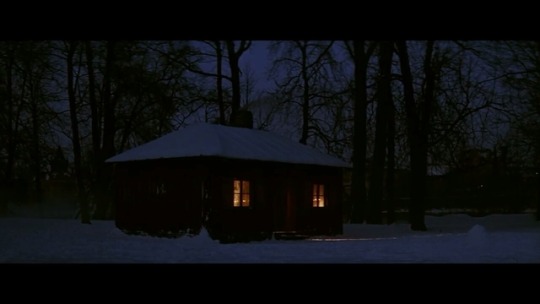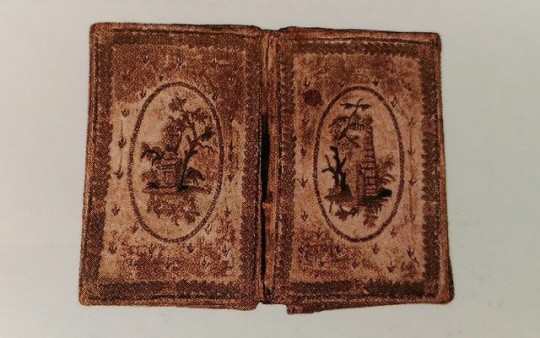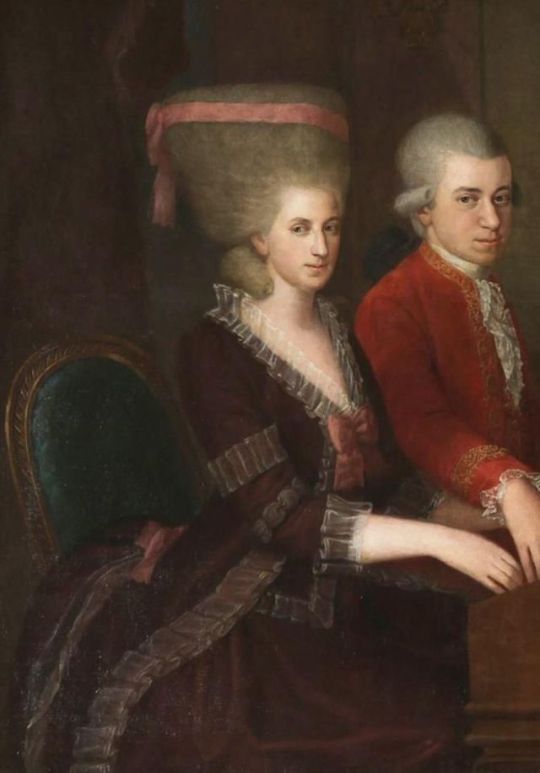#aboutmozart
Text
Reading Nannerl's diary is an interesting experience, because book reviewers and critics will sell it to you as this amazing window into the everyday life of an 18th century Austrian middle-class family, but it's mostly Nannerl roasting Wolfgang with entries like:
"May 16, my brother fell into a mud puddle. It's a nice day."
or
"May 25, my brother was watching the Corpus Domini procession from the window and dropped a lit candle on the crowd. Fun evening."
129 notes
·
View notes
Link
Short drabble created by me
10 notes
·
View notes
Text

The Magic Flute House
Not many people know that there is a small summerhouse in the Bastionsgarten, the garden of the International Mozarteum Foundation in Salzburg. It is a wooden structure that was originally located in the garden next to the "Theater auf der Wieden" in Vienna, the theater where Mozart's opera "The Magic Flute" was first performed in 1791, and it was donated to the Foundation in 1873. The little "Magic Flute House" is the house where Emanuel Schikaneder allegedly locked Mozart in order to make sure that he would finish working on "The Magic Flute" on time, and where the composer rehearsed some parts of the opera with the singers. The structure was restored several times, especially after it was damaged during the bombing of Salzburg in World War II. In Miloš Forman's "Amadeus" there is a reference to this little house towards the end of the film, as Mozart goes there to play with Schikaneder and his company of actors.

#wolfgang amadeus mozart#classical music#history#salzburg#the magic flute#opera#fun facts#aboutmozart#amadeus
98 notes
·
View notes
Text
As death, when we come to consider it closely, is the true goal of our existence, I have formed during the last few years such close relationships with this best and truest friend of mankind that death's image is not only no longer terrifying to me, but is indeed very soothing and consoling, and I thank my God for graciously granting me the opportunity...of learning that death is the key which unlocks the door to our true happiness. I never lie down at night without reflecting that —- young as I am — I may not live to see another day.
Wolfgang Amadeus Mozart, Letter to Leopold Mozart (April 4, 1787)
40 notes
·
View notes
Text

"I name a penalty!"
"Give her a good one!"
"Show us your legs!"
In this scene Constanze is given a penalty (showing her legs to the crowd) for losing a game, and according to Peter Shaffer the inspiration behind this scene was drawn from a real event, although it was actually quite the opposite situation. Around April 1782, when Constanze and Wolfgang were already officially a couple, a little incident happened: as a penalty during a parlor game, Constanze let a young man measure her legs (which, of course, was then considered highly inappropriate, especially for a young unmarried lady). When Wolfgang learnt about it, he wrote his fiancée to voice his disapproval: "... Why in the name of heaven did you not take the ribbon and measure your calves yourself? [...] you have allowed it to be done to you by a stranger with whom I have nothing to do." Apparently, Constanze didn't take the reprimand too well and temporarily broke off the relationship with Wolfgang (judging from Mozart's own letter to her: "You told me to my face that you intend to have nothing more to do with me. [...] Surely you do not hate me so much that I may be your friend no longer and you - no longer mine?"). Fortunately, the engagement was resumed when he apologized and offered to put the whole affair behind them, and they got married a few months later.
(In the picture: scene from "Amadeus", 1984)
#wolfgang amadeus mozart#constanze mozart#classical music#history#composers#aboutmozart#fun facts#amadeus
192 notes
·
View notes
Text
@the anon that asked me if I knew of any historical sources about Mozart and bisexuality: Tumblr didn't upload my reply and deleted the ask, so I hope you'll read this lol
Technically, there is no evidence of Mozart being non-heterosexual. All the documented romantic/sexual relationships he had involve women, particularly Aloysia Weber, his first love, his cousin Teckla, and Constanze Weber, his wife (plus alleged affairs with other women before and after marriage. Also, one time he told his father that he had "played with no less than 200 women" before getting married, so he wasn't just really into women but he was also a bit of a fuckboy). He had no problem showing his love for his friends, but no account (that I know of) would suggest that he was romantically or sexually involved with men as well.
However, I do encourage anyone who might have reliable sources that suggest otherwise to share them!
8 notes
·
View notes
Photo



Sorry
#wolfgang amadeus mozart#mozart#mean girls#fun facts#history#anecdotes#classical music#composers#meme#aboutmozart
6K notes
·
View notes
Photo

18th century silk wallet which belonged to Mozart (interior)
51 notes
·
View notes
Text

Maria Anna Walburga Ignatia "Nannerl" Mozart (30 July 1751 – 29 October 1829) fortepianist, harpsichord player, music teacher, composer and queen of the Kingdom of Back.
“[...] at three, Mozart was inspired to study music by observing his father's instruction of Marianne; he wanted to be like her” (Maynard Solomon)
“My dear sister! I am in awe that you can compose so well, in a word, the song you wrote is beautiful.” (W. A. Mozart, about Maria Anna's compositions)
(Picture: Mozart family portrait, Johann Nepomuk della Croce)
117 notes
·
View notes
Text

"der Bub heißt Joannes Chrisostomus, Wolfgang, Gottlieb" [Leopold Mozart announcing the birth of his son in a letter to a friend]
Mozart's names and nicknames.
Mozart was baptized on 28 January 1756, the day after his birth, at St. Rupert's Cathedral inSalzburg as "Joannes Chrysostomus Wolfgangus Theophilus Mozart". Mozart's first two baptismal names, "Joannes Chrysostomus", represent his saint's name, following the custom of the Catholic Church. They result from the fact that his birthday, 27 January, was the feast day of St. John Chrysostom. "Chrysostomus" means "golden mouth." "Wolfgangus" is "Wolfgang", adapted to the Latin used in the parish register. The composer used "Wolfgang" in German-speaking contexts. "Wolfgang," which means "wolf's path," was the name of the composer's maternal grandfather. "Theophilus" comes from Greek and is variously rendered as "lover of God" or "loved by God." "Gottlieb" is its German form, and the familiar "Amadeus" is its Latin form. "Theophilus" was a name of Mozart's godfather, the merchant Joannes Theophilus Pergmayr.
His family often used short forms of his first name "Wolfgang" such as Woferl, Wolferl, or the nickname Wolfganggangerl (in Salzburgian dialect "gangerl" means "little devil"). There is no evidence that his family used the nickname "Wolfie". The name "Sigismundus" was added after his Confirmation rites.
Mozart would often adapt his name(s) to foreign languages he spoke: in Italy, he would humorously sign his letters as "Wolfango Amedeo de Mozartini".
(Picture: Mozart's baptismal record)
168 notes
·
View notes
Text

Wolfgang Mozart (clavichord) and Thomas Linley (violin) playing together (Florence, April 1770).
"The 'Tommasino', as he is called, and the little Mozart, are talked of all over Italy, as the most promising geniuses of this age." (Charles Burney)
Thomas and Wolfgang - both aged 14 in 1770 - had met and become warm friends in Florence earlier in 1770. Thomas was one of the most precocious composers and performers that have been known in England, and became known as the "English Mozart". Linley drowned in a boating accident in 1778 at the age of 22.
Mozart later told fellow musician Michael Kelly that "Linley was a true genius" who "had he lived, would have been one of the greatest ornaments of the musical world".
121 notes
·
View notes
Text
Classical music has always been widely used in films, both as simple background music and as a key element. Here are the most "used" composers in cinematic history:
Wolfgang Amadeus Mozart (1327 films)
Richard Wagner (1222 films)
Ludwig van Beethoven (1219 films)
Johann Sebastian Bach (1208 films)
P. I. Tchaikovsky (944 films)
Felix Mendelssohn-Bartholdy (904 films, mostly in reference to the Wedding March)
Frederick Chopin (875 films)
Johann Strauss II (870 films)
Franz Schubert (690 films)
George Gershwin (673 films)
Gioacchino Rossini (667 films)
Giuseppe Verdi (652 films)
Note: the list is dated May 31st 2017 and may not be perfectly accurate in regard to the number of films per composer. Source: IMDb
#classical music#cinema#mozart#wagner#beethoven#bach#tchaikovsky#mendelssohn#chopin#johann strauss#schubert#gershwin#rossini#verdi#films#movie#history#fun fact#aboutmozart
1K notes
·
View notes
Text
Fun fact:
In 1786, Constanze fell ill and was bedridden. Wolfgang sat by her side and composed, while making sure no one would disturb his wife's sleep. Suddenly, a valet clumsily entered the room and startled Mozart so much that he jumped on his seat and accidentally stabbed his own thigh with a knife he used to sharpen his pen.
He tried not to scream in order not to wake Constanze up and ran in another room. He was later healed by his mother-in-law. He never told Constanze.
[Source: Sophie Weber]
2K notes
·
View notes
Text

The alleged photography of Constanze Mozart
Since first being brought to scholarly attention in 1958, numerous media sources and publications have asserted over the years that a single surviving photograph reportedly showing the only known image of Mozart's widow is that of Constanze (Mozart) Nissen herself at age 78 (picture, far left). The photo, or daguerreotype, was supposedly taken in Altötting, Bavaria in October 1840 outside the home of composer Max Keller. However, several Mozart scholars have refuted the claim as false for various reasons. First, the photograph could not have been taken outdoors since claims that the lenses to produce such images were not invented by Joseph Petzval until after Constanze had died in 1842. Second, it is documented that Constanze was crippled from debilitating arthritis in her final years of life. As Agnes Selby, author of Constanze, Mozart's Beloved, offered her opinion regarding the photograph on the Classical Music Guide Forums website on July 8, 2006: "There is absolutely no way she could have traveled to visit Maximillian Keller during the period when the photograph was taken. Contrary to the statements made in the newspaper, Constanze had no contact with Keller since 1826."
[Wikipedia]
16 notes
·
View notes
Text
Mozart and copyright
Part of the issues that Mozart had with his income came from the unauthorized publishing of his works. It has been observed that a number of compositions published under his name seem to be rather simple and unworthy of his talent from a technical viewpoint, but this is due to the fact that the composer often wrote easy pieces for pupils or admirers who asked for simple compositions for practicing purposes. Some of these people would then sell the music to publishers under Mozart's name to their own benefit, even though that music was never intended for publishing. According to an anecdote that can be found in Nissen's biography, a polish count who listened to a new composition performed by Mozart himself complimented the musician and asked if he could write a piece for him. Mozart accepted. The count later sent Mozart a sum of money and a letter that explained that it was meant to be a tribute to the musician's talent, to which Mozart gratefully responded by sending him the sheet music of the piece he had performed in his presence. Unfortunately, when the count came back and demanded the new composition, which Mozart had yet to write, he asked to have the money back. The composer returned the sum, but shortly after he found out that the count had had the composition published anyway without his permission. These situations were encouraged by the almost complete lack of copyright regulations at the time.
#mozart#wolfgang amadeus mozart#history#classical music#composers#facts#aboutmozart#anecdotes#copyright
70 notes
·
View notes
Text

Mozart slowly but unavoidably claimed his emancipation from his father through a series of actions, such as leaving his birthplace and family and later marrying a woman he loved, but that was not considered a suitable wife by his father and sister. It was indeed with this "unapproved" marriage that Wolfgang's relationship with his father came to a point of no return. However, the couple promised to eventually go and visit Salzburg in order to let Constanze meet her husband's relatives. Accounts of the meeting differ: some say that it was altogether satisfactory, some others say that it was a complete failure. It appears that in spite of the effort from both parts to be nice and friendly, the reception was rather cold. There's one anecdote in particular that shows how Mozart, who deeply wanted to bring about a reconciliation, was hurt by the constrained atmosphere: in the evening there wasn't much to talk about, so the Mozarts would often play some music. One time, while the family was singing the quartet "Andrò ramingo e solo" from Idomeneo (a piece that depicts a father, a son and two women torn by conflicting desires), Mozart got so upset that he burst into tears and left the room. It took Constanze a while before she could console him, but he would never admit the reason behind his action.
Mozart never returned to Salzburg after that visit in 1783.
(Picture: petition to the Marriage Bureau for Constanze Weber to marry Wolfgang "Adam" Mozart, 29 July 1782)
#wolfgang amadues mozart#history#classical music#facts#anecdotes#classical composers#idomeneo#constanze mozart#leopold mozart#aboutmozart
171 notes
·
View notes